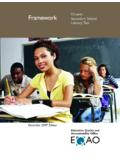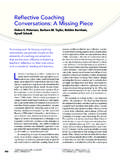Transcription of BRINGING LITERACY HOME - Every Child Ready to Read
1 BRINGING LITERACY HOME: An Evaluation of the Every Child Ready to Read Program By Susan B. Neuman, Naomi Moland, and Donna Celano ABOUT THE AUTHORS. Susan B. Neuman is Professor of Childhood Education and LITERACY Development at New York University's Steinhardt School of Culture, Education, and Human Development. Her work focuses on interventions in early childhood that change the odds for children who live in poverty. Naomi Moland is a Professorial Lecturer in the School of International Service at American University. Her research focuses on international education, out-of-school learning contexts, children's media, and diversity and multicultural education. Donna Celano is Assistant Professor, Department of Communication, at LaSalle University in Philadelphia. Her research interests focus on how children access and use media, including books and technology, related to early LITERACY and school readiness.
2 ABOUT ECRR. Every Child Ready to Read (ECRR) is a parent education initiative. It stresses that early LITERACY begins with the primary adults in a Child 's life. The ECRR program empowers public libraries to assume an essential role in supporting early LITERACY within a community. Visit for more information. ACKNOWLEDGEMENT. This project was made possible in part by the Institute of Museum and Library Services (IMLS). IMLS is the primary source of federal support for the nation's approximately 120,000 libraries and 35,000 museums. Its mission is to inspire libraries and museums to advance innovation, lifelong learning, and cultural and civic engagement. IMLS's grant making, policy development, and research help libraries and museums deliver valuable services that make it possible for communities and individuals to thrive. To learn more, visit Extensive effort has gone into ensuring the reliability of the information in this report; however, the publisher makes no warranty, express or implied, with respect to the material contained herein.
3 Published by the Association for Library Service to Children (ALSC) and the Public Library Association (PLA), divisions of the American Library Association. Get more information or contact us at or American Library Association 50 East Huron Street Chicago, Illinois 60611 USA. ISBN: 978-0-8389-8978-4 (PDF). 2017 by the American Library Association. All rights reserved. TABLE OF CONTENTS. 01 Executive 02 BRINGING LITERACY 03 Our 04 If These Walls Could 05 Beyond 06 More Than a Good 30. 07 Supporting 42. 08 Where There's a Lap, There's an App ..53. 09 Summary and 10 Appendix A: A Sample of Libraries 64. 11 Appendix B: Evaluation 69. BRINGING LITERACY Home: An Evaluation of the Every Child Ready to Read Program 3. 01. EXECUTIVE. SUMMARY. 01 EXECUTIVE SUMMARY. T. his report highlights findings culture, refurbishing play areas, and Focusing on parent engagement via from a three-year evaluation providing comfortable furnishings, the ECRR model has spawned many of Every Child Ready to Read families feel welcome to hang out, changes, including that public libraries (ECRR), a parent education initia- play, and read together.
4 Librarians' are now strategically designing their tive developed jointly by the Public roles are also shifting from focusing spaces to promote family engagement. Library Association (PLA) and the on children and reading to focus- Programming has moved beyond story time reading to a more expansive view Association for Library Service to ing on children and their parents. of how LITERACY develops, including Children (ALSC). As of this writing, They see themselves as educators, play and fun, STEM and STEAM, and over six thousand libraries have both of children and their parents. bilingual story times. invested in the ECRR Toolkit, which In addition, many librarians func- Library staff behavior is shifting from is used to implement ECRR in the tion almost as community or social focusing exclusively on children to also engaging parents and caregivers.
5 This library. ECRR is based on two core workers, drawing in families who shift better enables family members to concepts: reading begins at birth, might not otherwise visit. Librari- continue building LITERACY at home. and parents are a Child 's first and an programming is also changing, Librarians are modeling behaviors to best teacher. Librarians encourage offering family-friendly options that show parents how to increase early parents to interact and help build emphasize play, science, music, and LITERACY using the ECRR Five Practices. their children's vocabulary and exercise that invite all parents and Public librarians see themselves as educators, both of children and their early LITERACY skills using the Five children to participate. In many parents. Findings show that children Practices of talking, singing, read- libraries, programs are effectively also view librarians as educators.
6 Ing, writing, and playing. drawing large numbers of families Public librarians are embracing new who become weekly regulars. roles as community resource brokers Although seemingly simple, the ini- and social justice workers. They strive to reach all families in their communi- tiative represents a sharp turn in the In areas of need, libraries are playing ties, particularly those in distress. way many libraries approach chil- a vital role as resource brokers, help- These effective practices need to be dren's services. Previously, librarians ing to connect parents with services more widely implemented, with partic- focused their attention primarily on and resources, as well as a space ular attention paid to outreach and children, not on parent education. for parents and children to work on ongoing professional development. Today, librarians see that they can LITERACY skills.
7 Libraries also provide have a greater impact on early litera- resources for families to interact tively promote the use of technology cy by focusing on the primary adults using digital resources, such as com- during their programming. in a Child 's life parents and caregiv- puters, tablets, and e-readers. ers. By teaching adults the impor- Despite these challenges, libraries tance of early LITERACY and how to As seen in many areas, these chang- are emerging as community centers nurture pre-reading skills at home, es do not come without challenges. that promote family engagement, libraries can multiply the effects of Many libraries, particularly those thus serving an important mission of their efforts many times over. in areas of need, still struggle to fostering school readiness for chil- attract parents. In addition, not all dren in many communities.
8 ECRR's In visits to more than sixty librar- libraries are comfortable or capable flexible framework allows librarians ies nationwide, the research team of addressing parents during library to adapt the initiative to individual analyzed library spaces, conducted programming. The amount of out- community needs and interests, al- librarian interviews, and observed reach libraries conduct varies great- lowing ECRR to reflect the diversity library programs. Findings show ly, and libraries with less outreach of the many families libraries serve. that focusing on parent engagement are more limited in their ability to It looks, sounds, and feels differ- has spawned many changes. First, effectively serve as resource brokers ent in various parts of the country. libraries are strategically design- in areas of poverty. Finally, while However, the focus of this evaluation ing their spaces to promote family many libraries offer families a place is on how libraries are fulfilling one engagement.
9 By incorporating to use computers and other digital common mission: helping children d cor reflecting local customs and resources together, few libraries ac- arrive at school Ready to read. BRINGING LITERACY Home: An Evaluation of the Every Child Ready to Read Program 5. 02. BRINGING . LITERACY . HOME. 02 BRINGING LITERACY HOME. AN EVALUATION OF talking, singing, reading, writing, er, a 2009 evaluation of the pro- and playing. gram found that these skills were THE Every Child difficult to communicate to parents, The ECRR initiative, a joint effort of Ready TO READ the Public Library Association (PLA). so an updated and expanded edition was introduced in 2010. 3. PROGRAM and the Association for Library Service to Children (ALSC), is a Instead of five critical skills, librari- It's only 9:45 on a sunny San Fran- parent-education program operat- ans now focus on encouraging par- cisco morning, but the group of ing in about four thousand libraries ents to interact with their children fifty-one preschoolers, parents, and throughout the country.
10 At the heart using Five Practices critical to early caregivers lining up for the local li- of the initiative is a sharp turn in LITERACY : (1) talking, (2) singing, (3). brary's 10:15 Spanish-English Tod- the way many libraries approach reading, (4) writing, and (5) playing. dler Tales program know to get children's services. Traditionally, The ECRR Second Edition Toolkit here early. In this colorful neigh- early LITERACY programs at libraries contains resources such as Power- borhood, home to large numbers of have focused on children. During Point slides, brochures, handouts, Mexican immigrants, children's li- story times and other programs, and tip sheets, offering strategies brarian Laura warmly greets each librarians might model strategies on ways to promote the importance family as they enter. The children that parents can use to develop of the Five Practices.







